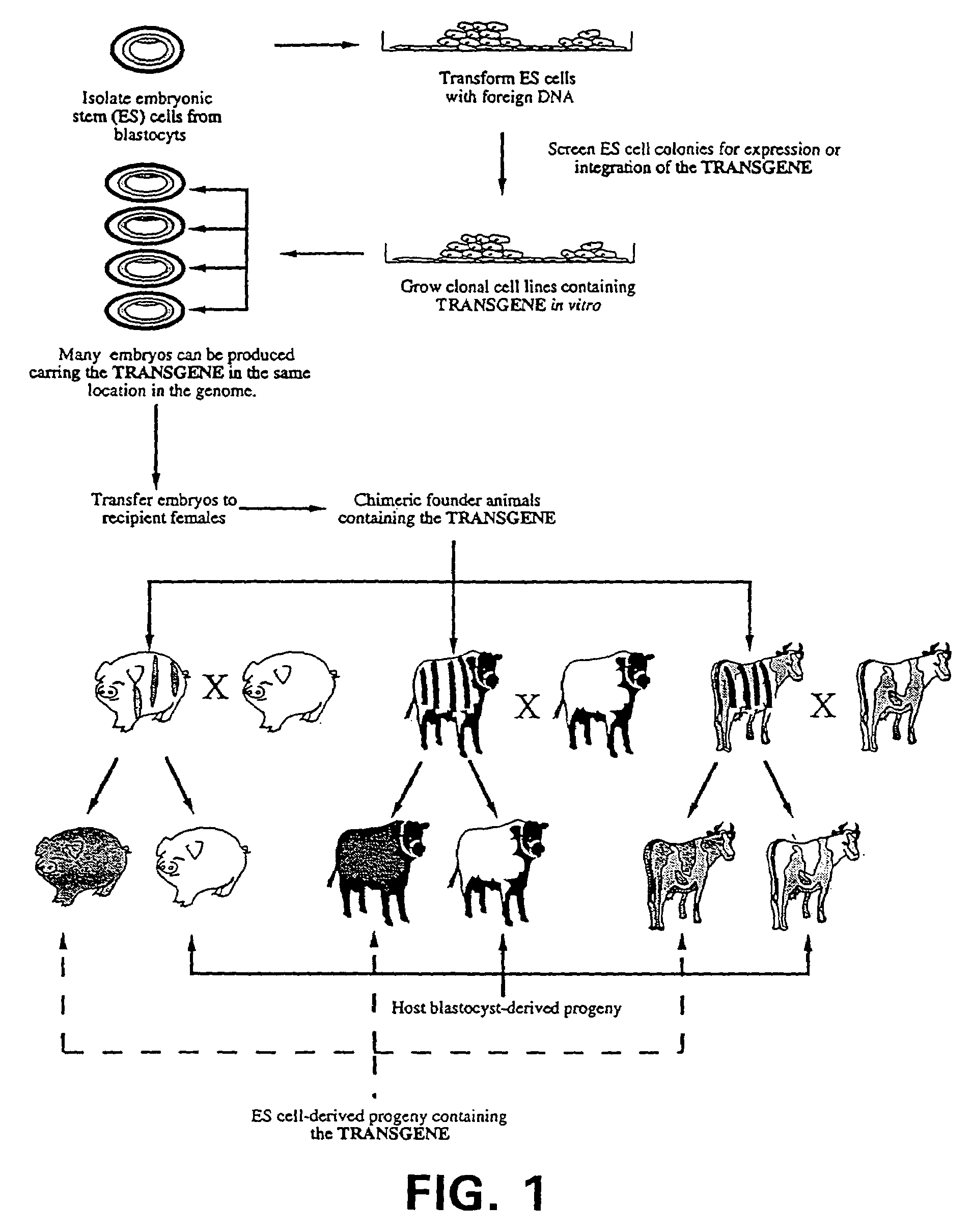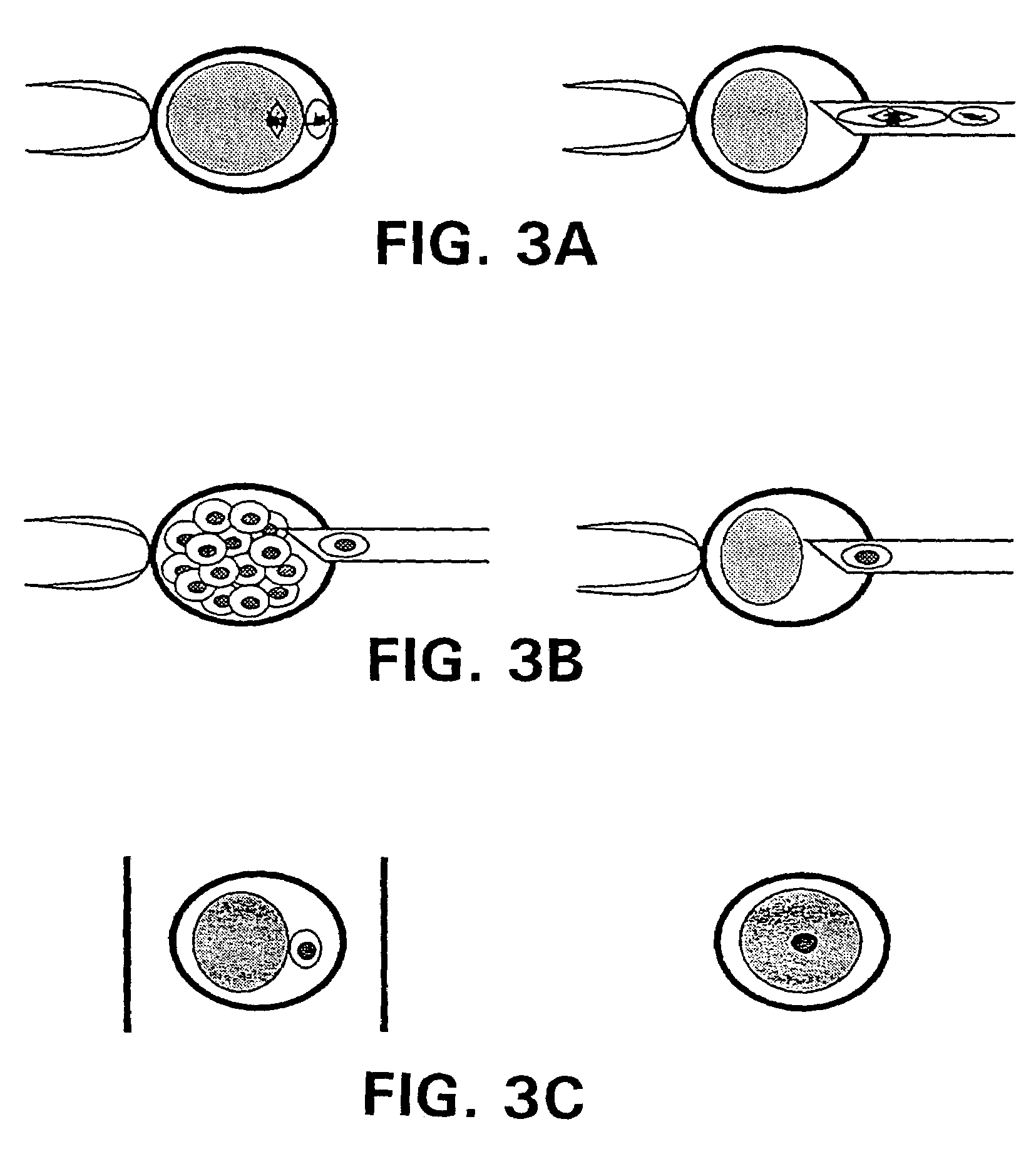Nuclear transfer with porcine embryonic stem cells
a technology of porcine embryonic stem cells and nuclear transfer, which is applied in the field of genetic engineering of nonhuman animals, can solve the problems of low efficiency of transgenic animals, especially large domestic animals, and limited number of genetically identical blastomeres
- Summary
- Abstract
- Description
- Claims
- Application Information
AI Technical Summary
Benefits of technology
Problems solved by technology
Method used
Image
Examples
example 1
[0109]Meishan females were bred to Meishan boars and embryos (four-cell, eight-cell, compact morula and blastocyst) were collected from Meishan females only (Experiment 1). Animals were euthanized. Within 30 min after reproductive tract removal, embryos were flushed from the tracts with D-PBS, randomized to treatment in a Whitten's based medium, washed three times and cultured in 50 μl drops underparaffin oil at 39° C. in ahumidified 5% CO2 in air environment. Embryos from four different stages (four-cell, eight-cell, compact morula and blastocyst) were cultured. In addition, four-cell embryos were cultured with either one or four embryos per drop to test the effects 10 of number of embryos per drop on development. A total of 260 four-cell, 35 eight-cell, 69 compact morulae and 64 blastocysts were cultured. The three protein supplements examined were 5% FBS (W-FBS), 0.4% BSA (W-BSA) and 5% FBS and 0.1% glucose (W-FBS+G). Embryos were examined every 12 h and a developmental stage end...
example 2
[0125]Four experiments were designed to develop an efficient method for activation of in vivo matured porcine oocytes for use in porcine nuclear transfer technology. All oocytes were flushed from oviducts with Beltsville embryo culture medium (BECM) and cultured in 50 μl drops of modified Whitten's medium+1.5% BSA under paraffin oil at 39° C. in a humidified 5% CO2 in air environment. Oocytes from the first three experiments were stained with Hoescht 33342 and viewed under fluorescent microscopy following 20 h of in vitro culture whereas oocytes from Experiment 4 were fixed, cleared, stained with aceto-orcein and viewed under light microscopy following 24 h of culture. The objective of the first experiment was to study the effect of ethanol on oocyte activation. Ethanol (7% for 5 min) had little effect on oocyte activation as only 8% activation was achieved for both treated and control oocytes. The objective of the second experiment was to determine the effects of cold shock treatme...
experiment 1
[0140]Unlike murine and bovine oocytes, in vivo matured porcine oocytes did not respond well to treatment with ethanol for activation. Similar results were reported for IVM porcine oocytes (Didion et al., 1990). Different levels as well as exposure times have been examined for oocytes from a number of species including murine (Cuthbertson, 1983), bovine (Minamihashi et al., 1993) and porcine (Petr et al., 1996). Although maximum activation rates were 15%, activation of IVM porcine oocytes occurred more often with 7 or 10% ethanol than with 0 or 5% ethanol for 3 min (Petr et al., 1996). General anesthetics (i.e., ethanol) have been associated with membrane events such as depolarization, displacement of Ca2+ from membrane phospholipids and cell fusion (Whittingham, 1980). The mechanism of activation for ethanol treatment appears to be different in porcine oocytes than murine or bovine oocytes. This could be due to a higher tolerance of porcine plasma membranes to perturbation by ethan...
PUM
| Property | Measurement | Unit |
|---|---|---|
| Nanoscale particle size | aaaaa | aaaaa |
| Fraction | aaaaa | aaaaa |
| Fraction | aaaaa | aaaaa |
Abstract
Description
Claims
Application Information
 Login to View More
Login to View More - R&D
- Intellectual Property
- Life Sciences
- Materials
- Tech Scout
- Unparalleled Data Quality
- Higher Quality Content
- 60% Fewer Hallucinations
Browse by: Latest US Patents, China's latest patents, Technical Efficacy Thesaurus, Application Domain, Technology Topic, Popular Technical Reports.
© 2025 PatSnap. All rights reserved.Legal|Privacy policy|Modern Slavery Act Transparency Statement|Sitemap|About US| Contact US: help@patsnap.com



